#the frescos are from the 1500s
Text
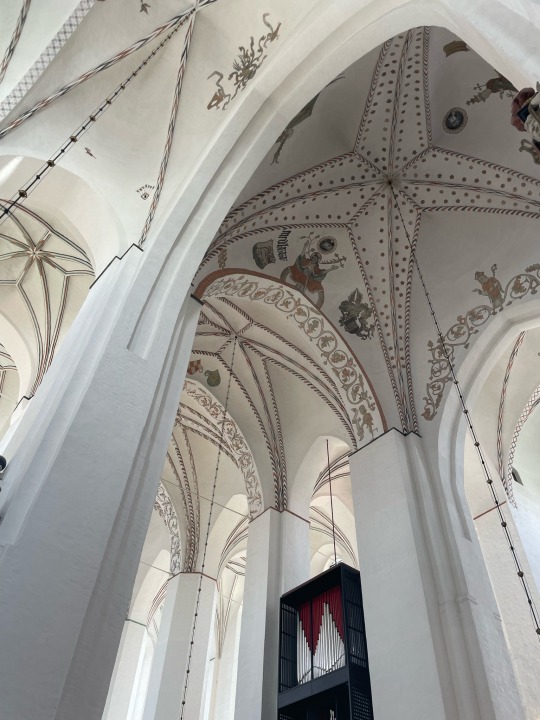
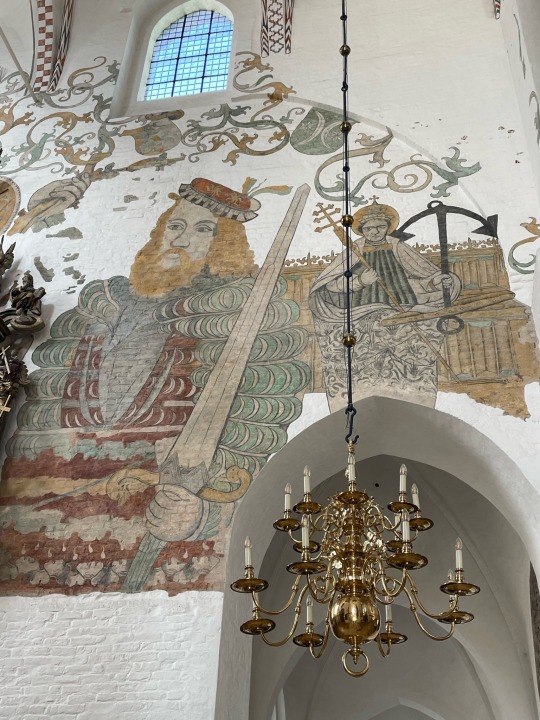
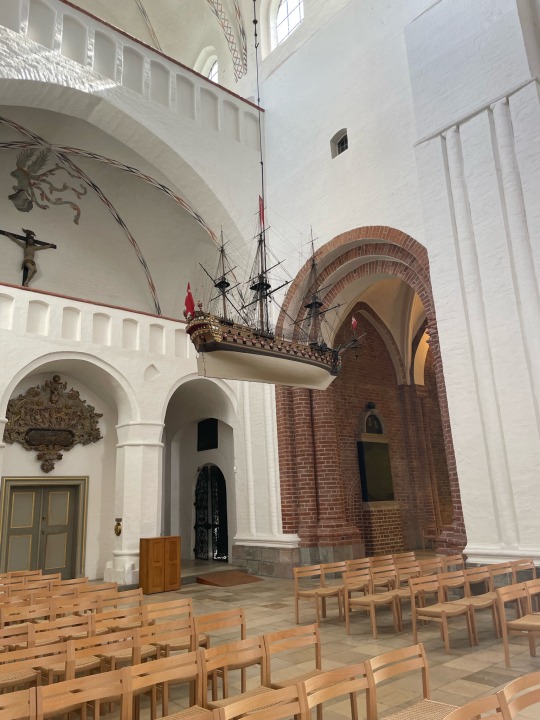



Saw a cool cathedral today (Aarhus, Denmark)
#the frescos are from the 1500s#after having read some books on the middle ages and now seeing this art in context i finally feel like i Get it#ive always thought art from this period was ugly (it is) but now thinking of those peasants looking up at these paintings... idk i get it#life was hard af#also im now of the opinion that all cathedrals should have whitewashed walls theyre so nice#and they really focus your attention
2 notes
·
View notes
Text

MWW Artwork of the Day (9/18/24)
Middle Minoan IIIB period (1600-1500 BCE)
Bull-Leaping (Taureador) Fresco (c. 1550 BCE)
Palace, Knossos
A fresco found at the Minoan site of Knossos, indicating a sport or ritual of "bull leaping." The loincloth worn by both men and women of Crete is shown in this fresco of a religious event where the women are light-skinned and the man is deeply tanned. This is the best of several similar scenes on the palace walls. The palace at Knossos was a place of high color, as were Greek buildings in the classical period, and as are Greek buildings today. In the MM Period, with the development of the art, white and black were added, and then blue, green and yellow. The pigments were derived from natural materials, such as ground hematite. Outdoor panels were painted on fresh stucco with the motif in relief; indoor, on fresh, pure plaster, softer than the plaster with additives ordinarily used on walls.
6 notes
·
View notes
Note
hi :) i am a training historian focusing heavily on art, and i saw your post about ancient rome on my timeline, and i just wanted to say a few things about your “why we don’t have black art.” of course, you did not ask for this, it just sparked some thoughts and i figured i would drop by and say hello! <3
but if you want to learn some more, here are my two cents xx
1. we’ve only excavated roughly 10ish percent of “ancient rome”. there is a LOT left to discover. the issue with archaeology is that it is very expensive and very laborious, and it takes a long while to reap any sort of reward.
2. back in the 19th and 20th centuries, safe excavation practices were pretty nonexistent, we didn’t have the ‘rule book’ that we do now, so to speak. there are stories of archaeologists using dynamite to dig- so, a lot of stuff has been lost to negligence and ignorance to proper ways of excavating. (it still happens today!) for example, a lot of egypt was excavated by random people, too! not trained archaeologists and historians. for a while, richer folks wanted to have hands on experience with history, so in the early 20th century that’s what they did. (i don’t blame them, i probably would too if i had a shit ton of money!)
3. rome was also notorious for flooding- it’s not on a very nice location geographically. even today, many parts of italy have flooded, destroying hundreds of art pieces and artifacts. (such as the great flood in florence, which happened in 1966) a lot of artifacts are lost to natural disasters.
4. a lot of stuff just doesn’t survive. the fall of rome happened in 476 AD, and that’s over 1500 years ago. an issue i have also discovered is that a lot of surviving tablets and letters from the ancient world are just…. receipts and lists. nothing juicy. they were just normal people, you know?
5. a lot of art from rome could also have been lost to religious wars during the middle ages. that is an academic speculation, but culture is typically the first to go during a religious war or crusade.
6. also, roman art was fragile. all art is. we have lost a multitude of great paintings and pottery because it doesn’t last very long. a big example of this is someone a bit more recent than rome- Da Vinci. He experimented a LOT with types of paintings and techniques. his last supper painting began deteriorating just a few years after he painted it, because he tried to do a well fresco using oil paints. (not good lol) art is not forever, unfortunately, so i can imagine a lot of roman pottery not lasting very long with how fragile it is.
also, one last thing. i think we tend to group ancient societies into one large homogenous blog, and i find that very modernist and dangerous. ancient rome was full of different dialects, people, and groups, and to say they were all one thing it very dangerous. same for ancient greece- it was made up of various tribes! sparta was not athens, etc etc.
i believe that that goes for all history, as well. even well up into the 20rh century.
racism, as we know it, is a fairly newer concept in the historical time line. a lot of slavery back in the ancient world was based on status and wealth, or who was better at fighting, and not necessarily skin color. (still absolutely horrible though. obviously!)
for example, ancient egypt was, as new evidence suggests, a thriving society with multiple people from multiple backgrounds. (we’ve discovered tombs with people who all have different types of skin colors, insinuating that the most important people in their society were made up of a rather inclusive bunch.) and the same goes for north africa, today and then- it is a beautiful and diverse part of the map, and not one country is the same, and neither are their people!
the world is not made up of horrible people, and i think it would do us all some good to remember that. there is more love than hate, there always has been, and we can see it in art throughout time <3 ah, but i digress!
anyways, I have put some beautiful ancient art below depicting people of color. the first one is my fave! xxx
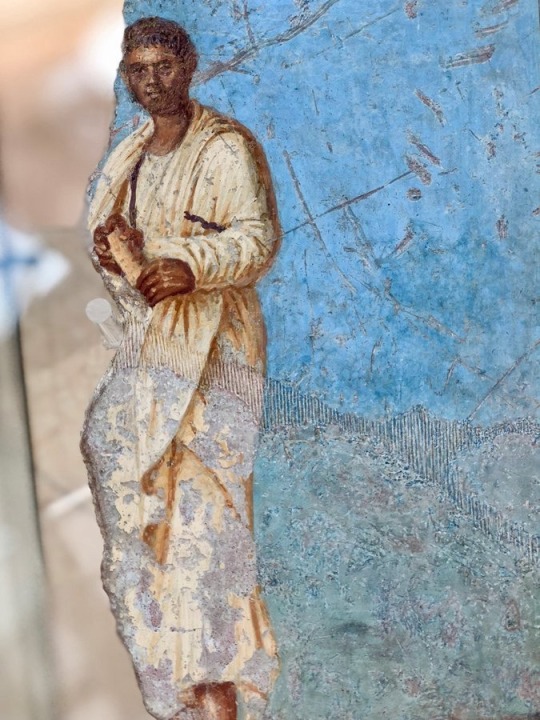



Hell yeah, thank you so much for this input!!!
(I have a lot of feelings about the era of the “I have money and no idea what I’m doing, I’m going to go eat a mummy.” Or “I’m going to go find Troy and inadvertently contribute to the Nazi platform.” (On that note, if you find that article interesting, I highly suggest these episodes of Behind the Bastards on the history of the swastika (part 1, part 2). Because at one point it really was just a symbol that like, every civilization on earth used at one point or another. And then a bunch of racist antisemites had to go and ruin it.) But seriously, Europeans loved eating mummies. Or using them in paint. And generally just destroying priceless artifacts for funsies. It infuriates me much the same way the fact the library at Alexandria was burned infuriates me, y’know?)
But I super agree with you vis a vis the fact we tend to paint “Ancient Rome” and similar societies/empires as a monolith. I mean… here hang on
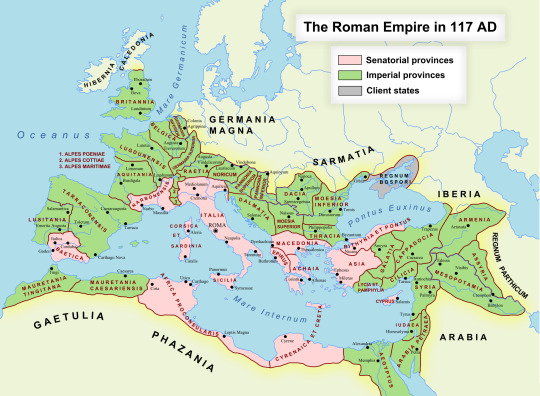
It goes without saying that today, Spanish culture is different from French is different from British, Italian, Greek, Turkish, Algerian, Egyptian, Palestinian, etc etc etc. And that still would’ve been the case at this point. Sure there was influence (and later, it’s hard to escape the influence of the Catholic Church) but it’s not like Roman soldiers showed up one day in all these different places and replaced the whole local culture with marble columns and olive oil. (I mean, there was probably a lot of olive oil, but that’s besides the point)
I would still argue that there is probably a reason that we don’t see as much Roman-era art of Black people as we probably could, and whose fault that is I don’t know—it could be modern curators, it could be those 19th/20th century “archaeologists,” it could be neither and just pure chance—but I am here right now begging people that if you’re writing in this era, think for a few seconds before you pull all of your inspiration from rows of Roman statues portraying white people. (Also, if I’m remembering correctly, those statues were painted some pretty wild colors at their height, which is neat)
ANYWAY, thank you for the extra info !! I appreciate your expertise on the matter :0 thank you very much for sharing!!
5 notes
·
View notes
Text
pinned post hours
i have no idea how i snagged this url but i'll treasure it forever
about me:
my name is jack (he/him) and i'm an ancient history/classical studies major! i plan to go into archaeology, concentrating on the late bronze age/early iron age aegean :)
i follow from @nethnad
i've been really into greek myths and legend since i was little, but i recently reread the iliad/odyssey and Oh God Oh Fuck The Thoughts Are Consuming
we get a little silly here. a little goofy even. perhaps we even steal some horses and swim in the sea and don't look at the thracian camp its totally fine :) its fine guys :)
aspects about greek myths/legends/the epic cycle i'm always down to clown about:
diomedes my boy diomedes my favorite child soldier turned peaceful farmer diomedes. does anyone perchance want to discuss breaking the cycle of violence when its all you've ever known this fine evening?
i also have many thoughts specifically about odydio/penodydio that consume my every waking moment. i dont even know where this came from it just Happened
telemachus!! especially the telemachy but also any thoughts about telemachus and legacies and his future at the end of the odyssey and how he's just. he's at the tail end of this age of heroes and i feel many many emotions about him!!!
teucer.... teucer..... can anyone hear me does anyone else feel a myriad of emotions about this side character from the iliad who is both trojan and greek and yet ultimately is at home with neither. literally his dad just exiled him holy fucking shit bro he just sacked his mom's city he killed his uncle's sons for you and for ajax and what does he get? he gets the boot. god. god. justice for my man teucer.
homeric epic to me is a tragedy (the end of an age of heroes, etc etc) but i am also captivated by how these characters try and heal from their pasts/break that cycle of constant warfare so if that ever floats your boat please come into my inbox we can have brainworms Together
pfp is from a vase of telemachus from the beazley pottery database, specifically this skyphos where he's standing with his spears by penelope and her loom. header on mobile/browser is from the ship procession fresco of house 5 from akotiri, thera/santorini. it dates from 2000-1500 BCE and i love it <3 <3 <3
7 notes
·
View notes
Photo
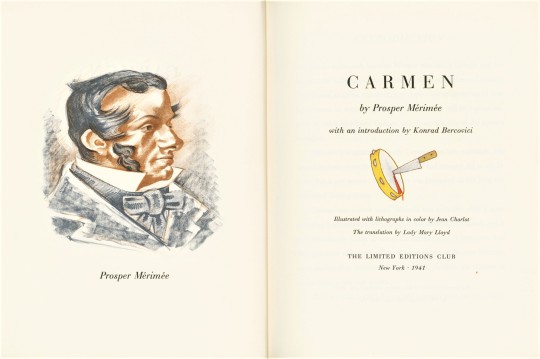
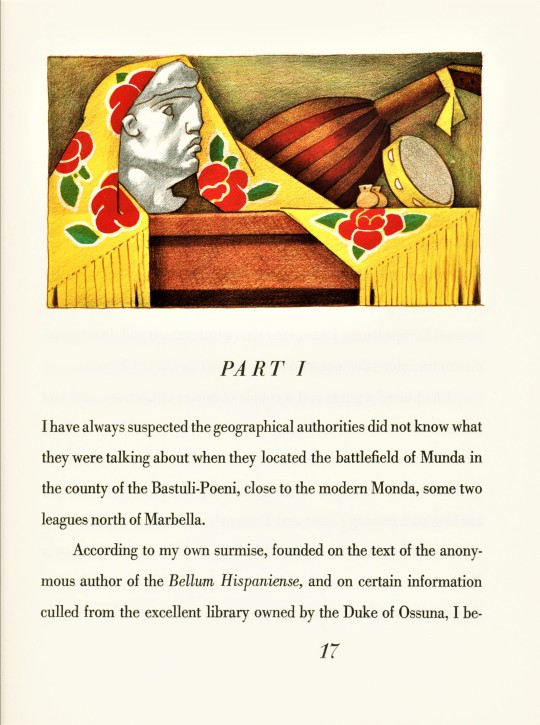

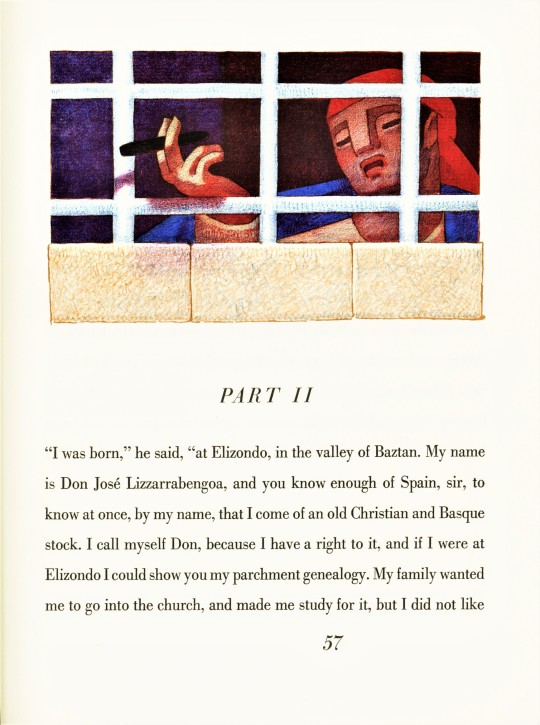



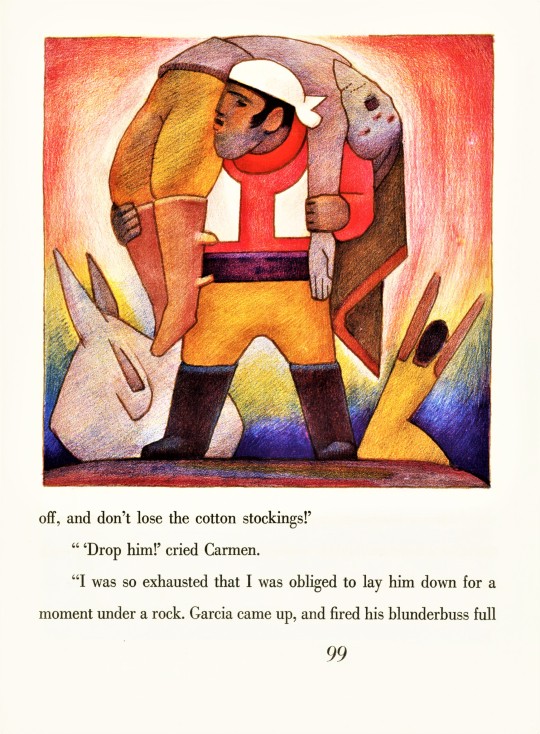
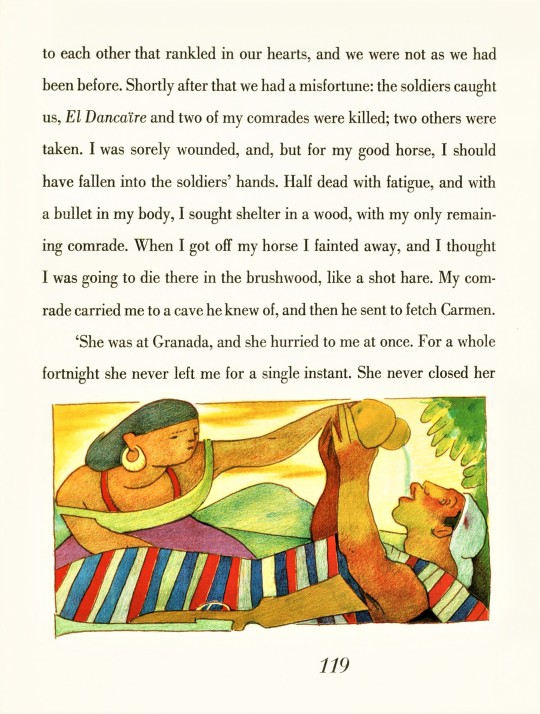
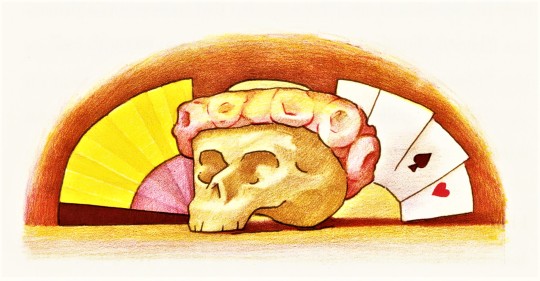
Fine Press Friday!
Our Limited Editions Club Shakespeare series keeps giving us more artists to look for in our collection! This week we found Carmen, by Prosper Mérimée (1803-1870) illustrated by French-born American painter and illustrator, Jean Charlot (1898-1979), published by the Limited Editions Club, New York, in 1941 in an unstated limited edition of 1500 copies signed by the artist. We learned about this edition because of the post we did a couple of weeks ago on Charlot’s illustrated edition of Shakespeare’s Henry VI, Part 3.
Mérimée’s 1846 novel about the eponymous Romani beauty, is most popularly well known from Georges Bizet’s famous opera of the same name, which is based on Part III of Mérimée’s story. The action is set in 1830s Andalusia, but Jean Charlot’s illustrations gives the story a Mexican flavor. Charlot worked mainly in Mexico and was a member of the Mexican Muralist Movement, sharing a studio with Fernando Leal who is considered to be one of the first Mexican Muralists. It was after the Mexican Revolution (1910-1917) that the new government sought to use murals to educate the public on social justice issues. From a young age, Charlot was fascinated by Mexican art and pre-Columbian artefacts and his mature work reflects this fascination, including in these illustrations.
The thirty-seven multi-layered color lithographs, which Charlot drew directly on the printing matrix, feel like miniature frescoes. Charlot laid down quick marks to color large areas of the image, which layer in overlapping color to give the image a lively energy. One could easily imagine one of the illustrations used as a page header as a mural above a doorway, signaling a transition. Or, one of the larger full-page illustrations as a mural on a large wall. I am taken by how these illustrations function well in both architectural and book spaces. The book is architecture.
The lithographs were printed by Charlot’s friend Albert Carman in New York and the type is 18-point Linotype Bodoni printed by Aldus Printers in New York. . The paper was made by the Worthy Paper Company, was watermarked with the name of the book and the covers are wrapped in a vibrant hand-blocked color silk.
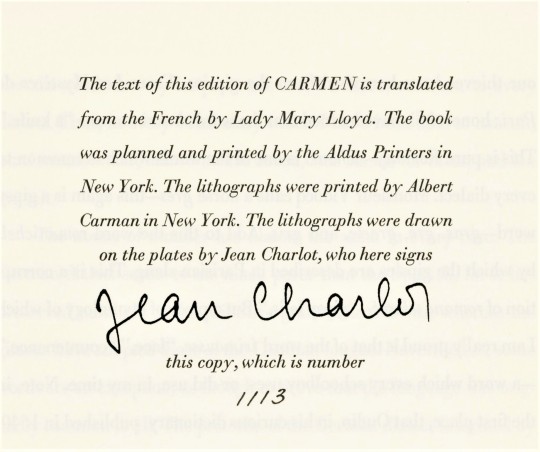

View more Limited Edition Club posts.
View more Fine Press Friday posts.
– Teddy, Special Collections Graduate Intern
#Fine Press Friday#Jean Charlot#Carmen#Prosper Merimee#Lithographs#color lithographs#Lithography#Limited Editions Club#LEC#Mexican Muralists#Murals#Mexican artists#American Artists#French Artists#Lady Mary Lloyd#Albert Carman#Aldus Printers#Fine press books#Linotype Bodoni#Bodoni type#Worthy Paper Company
59 notes
·
View notes
Text
An Historical Timeline of art materials throughout history: An ‘Ism’ Overview - Perspectives Comparing And contrasting art movements
Prehistoric Times:
Cave paintings were created using natural pigments like charcoal and ochre (40,000 BCE - 10,000 BCE).
Ancient Times:
Egyptians used materials such as stone, copper, gold, lapis lazuli, and pigments made from plants and minerals for their paintings and sculptures (c. 3100 BCE - 30 BCE).
Greeks used clay, bronze, and marble for their sculptures and fresco techniques for their paintings (c. 800 BCE - 146 BCE).
Romans used similar materials as the Greeks, but also developed new techniques for mosaic making (c. 753 BCE - 476 CE).
Middle Ages:
Medieval artists used pigments made from natural sources like plants, insects, and minerals, and materials such as wood, stone, and stained glass for their artwork (c. 500 CE - 1500 CE).
Renaissance:
Renaissance artists used a variety of materials including oil paint, canvas, wood, and marble (c. 1300 CE - 1600 CE).
Baroque:
Baroque artists used a wider range of materials such as pastels, chalk, and silverpoint, and developed techniques such as chiaroscuro and tenebrism (c. 1600 CE - 1750 CE).
19th Century:
The Industrial Revolution brought new materials such as synthetic dyes and oil paint tubes, which made painting easier and more accessible to artists (c. 1800 CE - 1900 CE).
20th Century:
Modern artists experimented with new materials such as acrylic paint, spray paint, and found objects, and developed new techniques such as collage and performance art (c. 1900 CE - present).
An then there’s now…
There are numerous materials used in the production of art in the 21st century(-ish). Here are some examples:
Digital Media: With the advent of technology, digital media has become a popular medium in contemporary art. Artists use software such as Adobe Photoshop, Illustrator, and 3D modeling programs to create their works. Some examples include:
Cory Arcangel's Photoshop Gradient Demonstrations (2011)
Rachel Maclean's video installations (2016)
Found Objects: Artists often use found objects, or everyday items, in their artworks. These objects are repurposed or combined to create new works of art. Some examples include:
Damien Hirst's shark preserved in formaldehyde (1991)
Ai Weiwei's installation of 9,000 bicycles in Toronto (2013)
Mixed Media: Mixed media refers to artworks that use a combination of materials and techniques. This can include painting, drawing, printmaking, collage, and sculpture. Some examples include:
Kara Walker's cut paper silhouettes (2005)
Robert Rauschenberg's Combines (1954-1964)
Performance Art: Performance art involves live actions by artists, which can be theatrical, improvisational, or conceptual. It often involves the use of the body as the primary medium. Some examples include:
Marina Abramović's The Artist is Present (2010)
Tino Sehgal's These Associations (2012)
Installation Art: Installation art is a genre of contemporary art that involves creating immersive, site-specific works that often utilize a variety of materials and techniques. Some examples include:
Olafur Eliasson's The Weather Project (2003)
Yayoi Kusama's Infinity Mirrored Room (2013)
These are just a few examples of the many materials and techniques used in contemporary art.
3 notes
·
View notes
Text

Two Unicorns. Minoan Fresco from Akrotiri (Santorini). Approximately 1500 BC
33 notes
·
View notes
Text
Commissions Info
Boosty Instructions
Log into boosty using whatever method you prefer (like google)
Go into settings and make sure you can receive and send DMs
Important: use a PC, cause Boosty doesn't jive well with mobile devices when it comes to payments.
set up a payment method. From my experience, US banks can be assholes about it, but it's not a scam.
When I complete the commission, I will send you a message with the art attached. It can be unlocked by paying the amount I set.
PLEASE make sure you're paying for the post and not sending a tip!
After that you can delete the payment method from your account if you feel like it.
Please don't send me tips, they're a pain in the ass to process for taxes lmao
Commission process
We agree on what type of commission you want
If you want a character design, send in a description and or sketches and or inspiration
If you just want art, send in refs. If you also send in a pose you want to see I will be immensely grateful.
I will send in sketches
When I'm done, I will send you the Boosty message with the invoice and the finished artwork attached. It will become available to you upon payment.
Commissions Rules
Will do:
Video game and ttrpg characters
creatures and monsters
cyborgs and robots
WIll not do:
NSFW art
anything hateful towards any group or person
lethal company nutcrackers
i may decline a commission for other reasons
Prices (in rubles, for a single character )
+60% for an extra character
+50% character design fee
corrections during sketch phase are free
Portraits
Symmetrical portrait icon - 300 rubles (single character)
just a little character face icon.






Monochrome symmetrical - 1000 rubles (single character)
a symmetrical portrait in black and white with an optional accent color



Monochrome - 1400 rubles (single character)
Same as above, but not symmetrical

Comicbook - 2000 rubles
A full color comic book style portrait of your character.



Fresco - 3000 rubles
A portrait in a semi-lineless style inspired by Dragon age cards


Full body
Comic - 3000-4000 rubles depending on complexity




Fresco - 5500 rubles and up, again, depending on complexity


Refs
i also do character refs, but these are limited to 1 of each per month because I find doing refs tedious.
Sketch miniref - 1500 - 3500 rubles
a colored sketch of a character design, 1-2 bodies, front and back. Not super detailed but is enough as a basic ref.


Miniref - 4500 - 6000 rubles
A cleaner version of the previous listing. Clean lines and flat colors. head turnaround + body and outfil + color palette + weapon (if applicable)

Full ref 8000 - 10000 rubles
Head turnaround, body turnaround, color palette, weapon (s), outfit(s)



2 notes
·
View notes
Note
Hey there!
You study antuquity, right?
Something I had a look at recently was an account by Poplar the Elder about a sort of half-evolution between Karrablast and Escavalier. He stated that if you gave a Karrablast only half of a shelmet's armour, that it would not fully evolve but would still adopt a partially armoured form with 'broken lances'. But perhaps most notably he referred to it as a 'Hypaspist' -An allusion to hellenistic armies as I'm sure you are aware. While in the middle ages we only have one or two Arcean frescoes depicting a 'Hypaspist' -and these depictions were probably based on Poplar's work. But considering the Hellenistic-based name, I was wondering if you've come across any evidence of this half-evolved Karrablast existing in any sources from antiquity?
what an interesting question, thank you!
apologies for getting to it late, life tends to life quite hectically. plus, i decided to do some further reading for this!
whilst the hellenistic period is something i've studied (one of my a-levels was dedicated to classical studies, and i took one module on the era this year), it's mostly a hobby at this point - i tend closer to medieval history now. however hammerlocke's library has a large source collection i was able to check out yesterday, and some were helpful for answering this.
so there was at least one account from a set of poems i was able to find from the period, that refers to a pokemon of a certain way. the translation used described it as "half-true", but it is likely that this is a metaphorical description for a potential half-evolution rather than actual pseudo-fiction.
one book (sheen, n. "the evolution of battle, 800 bce to 1500 ce", 1985) did include an interesting tidbit about battle formations from 100 bce, too, and ceramics and depictions from the time show armies working surprisingly extensively alongside ancient equivalents to escavalier and accelgor. and whilst some of the depictions on the artworks show unique pokemon that don't resemble either entirely, it's hard to say whether or not they are further evidence of the hypaspist or yet another ancient pokemon that we've not yet discovered. it seems likely that there was a potential evolution in such a manner, though, yes! if that is replicable in modern karrablast species, i wouldn't know. i've not seen any around, recently, to much dismay...
i would really recommend that book, by the way. it's got a lot of good historical background, alongside historiography from others in the field. there's a solidly sized section on kalosian warfare, i do believe, from 500 ce onwards.
#ask#pkmn irl#interactions#earthly musings#thank you very much! this was fun to look into. sorry for the late reply.
6 notes
·
View notes
Text
Ancient Aegean - Art History Notes
Original post link / Original post date: October 2 2023
Timeline:
3000-2000 BCE – [Aegean] – Early Cycladic Art
2000-1700 BCE – [Aegean] – Old Palace Period (Crete)
1700-1400 BCE – [Aegean] – New Palace Period (Crete)
1400-1200 BCE – [Aegean] – Mycenaean occupation of Crete
900-600 BCE – [Greece] – Geometric & Orientalizing
600-480 BCE – [Greece] – Archaic
480-400 BCE – [Greece] – Early & High Classical
400-323 BCE – [Greece] – Late Classical
323-30 BCE – [Greece] – Hellenistic
Vocabulary:
Cycladic – of the islands of the Aegean Sea, including Syros, Paros, Delos, Naxos, Keros, Melos, and Thera. This excludes Crete.
Minoan – art of the island of Crete.
Helladic – of the mainland of Greek.
Early Cycladic Art – 2600-2300 BCE
Cycladic Art is titled as such for the Cyclades in the Aegean Sea, which includes Syros, Paros, Delos, Naxos, Keros, Melos, and Thera, among other islands. They are named the Cyclades as the other islands seem to circle around Delos. This excludes Crete. Marble was found in the Aegean islands, which gave way to the beginnings of marble statues in Ancient Greece. The Cycladic art that we still have now consists of marble statuettes, which have a distinctive abstract style to them. Two of these art pieces are the Syros Woman and Keros Musician, both of which follow a similar style of great abstraction of the human form.
Minoan Art – Crete – 1700-1500 BCE
In this period, Cretan art is referred to as Minoan Art. There are two periods of Minoan art: Old Palace and New Palace. The “Palace” in question were large structures, of multiple rooms, on the island of Crete. These were most likely centers for religion, administration, and commercial works as opposed to residents for royalty- though, we are not sure. In cases like this, we have more evidence for one idea than another, so the one with more evidence is used more. The Old Palace period ended abruptly at 1700 BCE, most likely from an earthquake, which lead into the New Palace period as reconstruction immediately began. The largest palace complexes were at Knossos, Phaistos, Malia, Kato Zakro, and Khania. These were where Minoan life took place.
The largest of these palaces was at Knossos, where it was named to be the home of King Minos, labeling this palace as the home of the labyrinth of the Minotaur. It should be noted that this was given to the palace as a story as opposed to this myth happening. The English word labyrinth, however, comes from this type of floor plan used in this palace, with the intricate planning and scores of rooms. This layout, a “double ax” labrys, is reoccurring in Minoan architecture and art, representing a sacrificial slaughter. Many Greek myths were taken down generations orally and many of these stories pointed to the glory days of the times evermore ancient to the ancient Greeks; this myth is probably connected to the Minoans and their palaces while remaining a myth.
These palaces were constructed very well, made of sturdy stones embedded in clay, while sporting multiple stories. As true with most Mediterranean areas surrounded by water, Crete is mountainous and rocky, so these palaces accommodated building on top of this with multiple stories that made up for the depth of the slope. Meaning, there were parts of these palaces that were four-to-five stories tall. These palaces hosted drain systems for rain water, ventilation areas to fresh air, columns to hold the weight of the structure, and light wells to bring in natural light. Their columns were notably different than Greek or Egyptian columns of the time as they tapered from top to bottom, wide to narrower. The top was wide while the base was narrower.
Frescos were used to decorate these palaces, featuring nature paintings and aspects of Minoan life. These were achieved differently than Egyptian frescos, which was fresco secco, as the Minoan frescos were the first true buon fresco. To achieve this, they covered the rougher walls in white, fine lime plaster and painted onto the plaster as it was still wet. This means that the painting became a part of the wall, but the painters had a shorter amount of time to achieve the paintings. These paintings do not follow a strict canon, as the Egyptians did, but instead featured a very lively depiction of Minoan life with a freshness in the artworks.
Cycladic Art – 1600 BCE
Other frescos have been discovered, notably on the island of Thera, in Akrotiri, in the Cyclades. These were preserved by a volcanic eruption, with the area being buried in volcanic ash and pumice, similarly to how Pompeii was preserved. These frescos, as opposed to a palace/complex, decorated the walls of shrines and houses, making their number greater. These give us a better insight to how they once could have looked and their full compositions.
Minoan Art – 1800-1500 BCE
Minoan art also featured pottery which depicted nature, particularly the sea and its creatures. These pottery pieces were the first breaths of the style that the Greeks would adopt, morphing into red-figure and black-figure pottery. The Minoans did not have life-size statues or depictions of people or pieces of mythos, having a few smaller pieces remaining. We do not know of any mythos before the Ancient Greeks. A notable art piece is the Harvesters Vase, featuring relief sculptures, while being one of the first evidences of this area of the Mediterranean having an interest in the human body and further anatomy. It’s not well known when the full decline happened of the Minoan society, but we do know that the palaces were destroyed around 1200 BCE, with the Mycenaeans occupying the area before then. The cultural significance of these palaces faded around 1400 BCE.
Mycenaeans – 1600-1200 BCE
The Mycenaeans came to the Greek mainland at about 2000 BCE, being known as warriors who might have brought their wealth from the spoils of their victories. After Cretan palaces were destroyed, the Mycenaeans were left being the surviving Greek civilization. Mycenaean is the label placed on these people, but their fortifications were found at Mycenae, Tiryns, Orchomenos, Pylos, and other areas of Greece. These people became the silent subject of Greek mythos, as their fortifications were explained by later Greeks as being made by giants. The elite in this society were buried in bee-hive shaped tombs. The burial chamber, known as a tholos, consisted of a serious of stone, corbeled courses, laid on a circular base to form a dome. They created masks and daggers for their burials. They also produced one of the only life-size sculptures of this time on the Greek mainland. They had a distinctive illustration style on their pottery, separated from the Minoans.
———
This was a way to force me to write down notes about the greater ancient Greek world. So hopefully this was a nice little overview of the world before the Greeks.
I hope you enjoyed this little overview; make sure to make time for yourself today and drink some water-
Happy travels – Annie, the crosseyed cricket.
#art#art history#greek art#aegean art#ancient greece#ancient greek art#ancient aegean art#art education#art academia#academia#dark academia#greek
2 notes
·
View notes
Text
Palazzo Vecchio
The year is 1500, and I find myself standing in front of Palazzo Vecchio, Florence’s authoritative town hall. This genuine medieval fortress was built in 1299-1314 and became the physical manifestation of the city’s power. Overlooking it, there is the Arnolfo Tower which provides a bird's eye view of the entire city. As I step inside the massive door that seamlessly opens to the grand Hall of the Five Hundred, one can only marvel at the gigantic frescoes done by Giorgio Vasari that portrayed various conquests and triumphs of Florence, the city.
It is a work of active governmental officials who decide the future of the city seen from the point of view of the hall. The ceiling and the walls are covered with frescoes and sculptures making the building look like a symbol of the political and cultural authority of Florence. Strolling through the palace I get myself a feeling of antiquity. Every room, be it the living quarters of the king and members of his court or the meeting rooms of the council, is a drama in the narrative of the power of art and governance.
Going further I find such things as the secret stairs and doors that are hidden behind something that makes the palace mysterious and interesting. The private rooms of the Medici family are richly ornamented, which proves the well-off position of the explored family. It has artworks painted on the walls, basic forming scenes based on mythology and history adding tremendous art and cultural value.
Outside people are bustling, and vendors in the piazza are calling to attention their new arrivals. A variety of merchants’ voices shout; Hora! Onis! Men transform into children while playing around the fountain. You can hear the aroma of roasting chestnuts, and the voices of the Florentines are added to the strong cook’s noise in the background; When I enter Palazzo Vecchio I realize that I am touching the main pulse of Renaissance Florence, the city full of ambition, arts, and innovations.


0 notes
Text

Octopus: Minoan fresco from the ruins of Knossos Palace, Crete. The cyclopean building – which had more than 1500 rooms– was built around 2000 BC. Earthquakes and wars devastated it and it was abandoned eventually, in 1400 BC, coinciding with the decline of the Minoan civilization, to be reused later by the Dorians and Romans.
0 notes
Text
Exploring the Magnificent Karni Mahal Palace in Udaipur
Ever dream of staying in an Indian palace fit for royalty? Then you need to visit the Karni Mahal Palace in Udaipur. This architectural wonder will transport you back in time with its grand marble staircases, towering domes, and intricately carved stone facades.Built in the late 16th century, the palace was originally the royal hunting lodge for the Maharajas of Mewar. Now open as a luxury heritage hotel, you can experience the lavish lifestyle of Indian royalty. From the moment you arrive, you'll be greeted with traditional music and dancing, then whisked off to your opulent suite filled with antique furnishings and vibrant textiles. Your days will be spent exploring the palace's many courtyards, halls and balconies with panoramic views of the Aravali Hills and Pichola Lake. By night, dine on authentic Rajasthani fare under the starry night sky. A stay at the Karni Mahal Palace is a once in a lifetime chance to live like a king or queen. What are you waiting for? Your royal adventure awaits!
The History and Architecture of Karni Mahal Palace
The magnificent Karni Mahal palace has a rich history dating back to the early 1500s. Built during the reign of Rana Kumbha, the palace was originally used as a hunting lodge for the royals. The architecture is a stunning blend of Rajasthani and Mughal styles with intricately carved pillars, latticed windows, and frescoed walls.
As you explore the palace, you’ll notice the attention to detail in every corner. The Durbar Hall is adorned with exquisite glass inlay and mirror work, while the palace bedrooms feature hand-painted floral motifs. The palace also houses an ancient Shiva temple, adding to its historic charm.
Over the centuries, Karni Mahal has witnessed many significant events in Udaipur’s history. It was used as a shelter for British troops during the Sepoy Mutiny of 1857 and also hosted many extravagant royal weddings and festivals. Today, this architectural wonder has been carefully restored and converted into a heritage hotel, allowing guests to experience its old-world opulence.
A visit to the palace transports you back in time. As you wander through the courtyards and corridors, it’s easy to imagine what life must have been like during its golden age. Karni Mahal is truly a window into Udaipur’s rich and vibrant past. Whether you’re an architecture buff, a history enthusiast or simply a leisure traveler, the palace is sure to captivate you with its timeless beauty and grandeur.
Visiting Karni Mahal: What to See and Do
Once you arrive at the grand Karni Mahal Palace, get ready for a fun-filled day exploring all it has to offer.
The Palace Grounds and Architecture
The palace architecture alone is reason enough to visit. Walk around and admire the intricate stone carvings, arched doorways, and vibrant murals. The palace was built in the 1930s, combining elements of Rajasthani and Mughal architecture with Art Deco details. Don't miss the striking Karni Vilas, the palace's luxurious art deco wing.
The Palace Museum
The palace museum houses many historic artifacts like paintings, sculptures, and pottery. Some date back to the 8th century! It offers a glimpse into the rich cultural heritage of the area.
The Palace Pool
Take a stroll around the scenic palace pool, which is flanked by lush greenery and marble walkways. You may even spot vibrant birds like parrots in the trees. The pool looks especially stunning at night when lit up.
Shopping at the Palace Bazaar
No trip to the palace is complete without visiting the palace bazaar. You'll find handcrafted goods like colorful textiles, jewelry, pottery and more. It's a great place to pick up unique souvenirs or gifts. Haggling is expected, so bargain for the best deals!
A day exploring the magnificent Karni Mahal Palace will leave you in awe of its beauty and immersed in the local culture. There are endless discoveries to be made in this iconic symbol of Udaipur's rich history.
Tips for Getting the Most Out of Your Karni Mahal Visit
To make the most of your visit to the magnificent Karni Mahal Palace, here are a few tips:
Book a guided tour
Booking a guided tour is the best way to learn all about the history and architecture of the palace. The knowledgeable guides will walk you through the palace, telling stories about the royal family and pointing out architectural details you might miss on your own. Tours also provide access to parts of the palace not open for self-guided visits.
Visit early
The palace opens at 9 am, so arrive as early as possible to beat the crowds. The palace receives thousands of visitors per day, especially during peak season, so arriving early ensures you can explore the palace at your leisure before it gets too busy. You'll have more opportunities for photos without other tourists in the background.
Dress respectfully
Remember you are visiting an historic royal palace, so dress conservatively. For women, cover your shoulders and knees. For men, wear pants and a shirt. The palace staff may deny entry to visitors dressed in shorts, tank tops, or other revealing attire.
Take your time
With over 300 rooms, the Karni Mahal Palace deserves at least 2-3 hours of exploration. Some of the highlights you don't want to rush through include:
The mirrored ceiling gallery with its intricate tile work
The palace balconies offering panoramic views of the city
The royal courtyard, used for public appearances and events
The lush palace gardens, filled with native plants, flowers and birds
Spend time simply soaking in the ambiance and imagining what life was like as royalty in Udaipur. A leisurely visit will allow you to fully appreciate the grandeur and opulence of the Karni Mahal Palace.
Conclusion
So there you have it, a glimpse into the magnificent Karni Mahal Palace in Udaipur. With its beautiful architecture, opulent decor, and rich history, it's no wonder this palace is considered a jewel of Udaipur. Whether you're interested in learning about the royal families that once lived here, admiring the intricate stone carvings and paintings, or simply soaking in the ambiance, Karni Mahal Palace is a must-see when visiting Udaipur. Make sure to give yourself plenty of time to explore all it has to offer. And who knows, as you wander the palace corridors and courtyards, you might just feel like royalty yourself in this little slice of palace paradise. What are you waiting for? Start planning your royal Rajasthan adventure today!
0 notes
Text




Aegean art
Art developing in the Aegean basin, mainly in the Bronze Age (3000--1100 BC)
It had several regional varieties: Cretan art in Crete, Helladic art, called also in its last phase (1600-1100 B.C.) Mycenaean art of mainland Greece, Cycladic art in the Cyclades, or art on the west coast of Asia Minor (Troy): there was a flourishing of architecture, the so-called palaces (Knossos, Phaistos, Malia, Zakro from the 1st half of the 2nd millennium BC), defensive citadels with cyclopean walls in mainland Greece (Mycenae, Pylos, Tyryns from the 2nd half of the 2nd millennium BC), monumental domed tombs (Atreus Treasury) and others ; painting developed: wall painting in palaces and houses (preserved in very good condition, among others, on the Cycladic island of Thira), on larnax, on ceramics (including Kamares vases), fine art (including Cycladic idols), relief representations (including the monumental Lion Gate in Mycenae from around 1250 BC), glyptics, goldsmithing (including a set of goldsmith products from shaft graves in Mycenae with the famous masks of rulers, two cups from Wafio); many elements of Aegean art were continued in Greek art.
1. Reconstructed fragment of the Knossos palace
2. Lady carrying a pyxis, fresco from Tyrnys
3. Partridges, fresco from Knossos, c. 1500 BC.
4. Agamemnon's Mask
source: Literatura i sztuka od starożytności do baroku
0 notes
Text
Ambrogio Lorenzetti (Sienese school, c. 1290–1348), The Allegory of Good and Bad Government (Allegoria ed effetti del Buono e del Cattivo Governo), 1338, Palazzo Pubblico, Siena, Italy, Fondazione Musei Senesi., ‘Effects of Good Government in the City’, Waffle, Stroopwafel, worldwide_waffle, Getty Egyptomania! Explore King Tutankhamun's tomb on the 100th anniversary of its discovery, Three scenes from the afterlife of Tutankhamun as seen on the north wall of his burial chamber., Medieval Updates Cambridge Studies in Medieval Literature Imagining the Medieval Afterlife, ed. Richard Matthew Pollard, ‘Visions of the otherworlds in the late middle ages, c.1300–c.1500 Gwenfair Walters Adams’, ‘Dante's other-worldly surprises and this-worldly polemic George Corbett’, Christie's Venice's enduring magic: how the city inspired artists from Canaletto to Manet The Paul G. Allen Collection. Giovanni Antonio Canaletto (1697-1768) and Henri Edmond Cross (1856-1910), Centre for the Study of Medicine and the Body in the Renaissance - CSMBR Medical Objects in Context An instrument for Diseases Prediction, Prague 1585, Germanishes National Museum, Nuremberg, Germany., CERN LHCb Experiment at CERN VErtex LOcator (VELO), The new VELO’s job is to completely reconstruct the trajectories of particle collisions with extreme precision, pick out the important interactions involving B mesons, and analyse them., Schoenberg Institute for Manuscript Studies We refer to our manuscripts using shelfmarks #ManuscriptBasics
Ambrogio Lorenzetti (Sienese school, c. 1290–1348), The Allegory of Good and Bad Government (Allegoria ed effetti del Buono e del Cattivo Governo), 1338, Palazzo Pubblico, Siena, Italy, Fondazione Musei Senesi., ‘Effects of Good Government in the City’, Waffle, Stroopwafel, worldwide_waffle, Getty Egyptomania! Explore King Tutankhamun's tomb on the 100th anniversary of its discovery, Three scenes from the afterlife of Tutankhamun as seen on the north wall of his burial chamber., Medieval Updates Cambridge Studies in Medieval Literature Imagining the Medieval Afterlife, ed. Richard Matthew Pollard, ‘Visions of the otherworlds in the late middle ages, c.1300–c.1500 Gwenfair Walters Adams’, ‘Dante's other-worldly surprises and this-worldly polemic George Corbett’, Christie's Venice's enduring magic: how the city inspired artists from Canaletto to Manet The Paul G. Allen Collection. Giovanni Antonio Canaletto (1697-1768) and Henri Edmond Cross (1856-1910), Centre for the Study of Medicine and the Body in the Renaissance - CSMBR Medical Objects in Context An instrument for Diseases Prediction, Prague 1585, Germanishes National Museum, Nuremberg, Germany., CERN LHCb Experiment at CERN VErtex LOcator (VELO), The new VELO’s job is to completely reconstruct the trajectories of particle collisions with extreme precision, pick out the important interactions involving B mesons, and analyse them., Schoenberg Institute for Manuscript Studies We refer to our manuscripts using shelfmarks #ManuscriptBasics
https://blog.naver.com/artnouveau19/222918462045
Ambrogio Lorenzetti (Sienese school, c. 1290–1348), The Allegory of Good and Bad Government (Allegoria ed effetti del Buono e del Cattivo Governo), 1338, Fresco, 7.7 x 14.4m (room), Palazzo Pubblico, Siena, Italy, Fondazione Musei Senesi., ‘Effects of Good Government in the City’
The Allegory of Good and Bad Government
The Allegory of Good and Bad Government is a series of three fresco panels painted by Ambrogio Lorenzetti between February 1338 and May 1339. The paintings are located in Siena's Palazzo Pubblico—specifically in the Sala dei Nove ("Salon of Nine"), the council hall of the Republic of Siena's nine executive magistrates,[2] elected officials who performed executive functions (and judicial ones in secular matters). The paintings have been construed as being "designed to remind the Nine [magistrates] of just how much was at stake as they made their decisions".[3]
Considered Lorenzetti's "undisputed masterpiece",[4] the series consists of six different scenes (the titles are all modern conveniences):
Allegory of Good Government
Allegory of Bad Government
Effects of Bad Government in the City
Effects of Bad Government in the Country
Effects of Good Government in the City
• Effects of Good Government in the Country
https://en.wikipedia.org/wiki/The_Allegory_of_Good_and_Bad_Government
Effects of Good Government in the City
https://en.wikipedia.org/wiki/The_Allegory_of_Good_and_Bad_Government#/media/File:Ambrogio_Lorenzetti_-_Effects_of_Good_Government_in_the_city_-_Google_Art_Project.jpg
Ambrogio Lorenzetti (Sienese school, c. 1290–1348)
Ambrogio Lorenzetti (Italian pronunciation: [amˈbrɔːdʒo lorenˈtsetti]; c. 1290 – 9 June 1348)[1] or Ambruogio Laurati was an Italian painter of the Sienese school. He was active from approximately 1317 to 1348. He painted The Allegory of Good and Bad Government in the Sala dei Nove (Salon of Nine or Council Room) in Siena's Palazzo Pubblico. His elder brother was the painter Pietro Lorenzetti.
https://en.wikipedia.org/wiki/Ambrogio_Lorenzetti
Waffle
A waffle is a dish made from leavened batter or dough that is cooked between two plates that are patterned to give a characteristic size, shape, and surface impression. There are many variations based on the type of waffle iron and recipe used. Waffles are eaten throughout the world, particularly in Belgium, which has over a dozen regional varieties.[1] Waffles may be made fresh or simply heated after having been commercially cooked and frozen.
https://en.wikipedia.org/wiki/Waffle
Stroopwafel
A stroopwafel (Dutch pronunciation: [ˈstroːpˌʋaːfəl] (listen); literally 'syrup waffle') is a thin, round waffle cookie made from two layers of sweet baked dough held together by caramel filling.[2][3] First made in the city of Gouda, South Holland, Netherlands, stroopwafels are a well-known Dutch treat popular throughout the Netherlands and the former Dutch Empire,[citation needed] and exported abroad.
https://en.wikipedia.org/wiki/Stroopwafel
worldwide_waffle
@WaffleWorldwide
·
Oct 21
Any #waffle plans this #weekend?
https://twitter.com/WaffleWorldwide/status/1583394492467773440
https://worldwidewaffle.com
Getty Egyptomania! Explore King Tutankhamun's tomb on the 100th anniversary of its discovery, Three scenes from the afterlife of Tutankhamun as seen on the north wall of his burial chamber.
Getty
@GettyMuseum
King Tut's tomb is one of the most visited tourist sites in the world. How the stress of tourism threatened the tomb's wall paintings:
https://twitter.com/GettyMuseum/status/1587917470697865216
Egyptomania!
Explore King Tutankhamun's tomb on the 100th anniversary of its discovery
Three scenes from the afterlife of Tutankhamun as seen on the north wall of his burial chamber.
Photo: Carleton Immersive Media Studio
By Alexandria Sivak
Nov 02, 2022
What comes to mind when you think of King Tut?
It’s certainly true that Tut’s tomb is a universally celebrated symbol of ancient Egypt. Discovered in 1922 by archaeologist Howard Carter, the tomb’s trove of funerary objects—furniture, jewelry, clothing, and elaborate wall paintings among them—captured the popular imagination in unprecedented ways.
This year marks the 100th anniversary of the site’s discovery. Since our collective fascination with ancient Egypt has little changed, and heavy tourism to Tut’s tomb continues to this day, much has been done to preserve it for generations to come, including conservation efforts led by a team from the Getty Conservation Institute (GCI) and the Egyptian Ministry of Tourism and Antiquities. But let’s first delve into what initially drove the discovery of Tut’s resting place.
Why the Obsession with Ancient Egypt?
On a grander scale, the pyramidal tomb of Roman magistrate Gaius Cestius in Rome is unmistakable in its homage to Egyptian heritage, albeit on a much smaller scale than the pyramids of Giza.
The invasion of Egypt by French general Napoleon Bonaparte in 1798 brought a resurgence of interest. For his expedition, Napoleon assembled a team of 167 scholars and scientists, known as the Commission of the Sciences and Arts, and charged them with gathering as much information as they could about the art, culture, and history of the region.
Although the French were eventually driven out of Egypt, the commission’s work endured, resulting in their publication of The Description of Egypt and Vivant Denon’s Travels in Upper and Lower Egypt— reports that enchanted populations across Europe and elsewhere. The commission’s efforts also led to the discovery of the Rosetta Stone, one of the world’s most important archaeological finds and the key to understanding Egyptian hieroglyphics.
Carter’s Big Score
Archaeologist Howard Carter walks beside a group of people carrying an artifact through a desert. Photograph from The Tomb of Tut-Ankh-Amen, by Howard Carter and A. C. Mace. Image source: Wikimedia Commons
Photo: Harry Burton
Enter the Tourists
While the tomb is considered small compared to those of other Egyptian rulers, it was surprisingly well-preserved. Probably constructed hastily when Tut died unexpectedly before reaching his 20s, the site was later buried by debris when a subsequent tomb was constructed. Though not completely undisturbed, Tut’s resting place remained relatively intact until Carter’s discovery.
Conservators to the Rescue
In 2009 the GCI partnered with Egypt’s Supreme Council of Antiquities to create a conservation and management plan that would allow for tourism but keep the tomb safe from further damage. After performing the most thorough study of the site since Carter’s time, the GCI and its Egyptian colleagues developed strategies for the tomb’s conservation and presentation.
The team designed a new viewing platform that increased visitor access and protected the wall paintings. A new filtered air supply and exhaust ventilation system helped control humidity, carbon dioxide, and the influx of dust. The flaking paint of the wall paintings was stabilized, plaster was repaired, coatings from previous treatments were reduced, and dust was safely removed. The tomb was also given new lighting and signage that have improved the visitor experience and enhanced understanding of the site and its history.
GCI staff perform conservation work in the tomb of Tutankhamun in the Valley of the Kings, Egypt.
As for the brown spots, extensive DNA and chemical analysis determined that they were microbiological growths that were dead and no longer a threat to the wall paintings. Still, the existing spots had penetrated the paint layer and could not be removed without causing damage.
A major goal of modern conservation projects is to ensure the long-term sustainability of conservation efforts and to provide local professionals with the tools and support they need to maintain their heritage sites for the future. For the Tut project, this meant training those professionals and developing a manual that provides guidance for the tomb’s continued maintenance as well as recommendations for future changes and improvements. It also meant working with teams on the ground to continue environmental monitoring. The GCI completed its work in 2019, and today the tomb and its contents remain better protected.
Two people work with an environmental monitoring machine outside the tomb of Tutankhamun in Egypt.
Jeanne Marie Teutonico, associate director of strategic initiatives and publications at the GCI, believes the 100th anniversary is a chance to discuss more than Carter’s discovery and the mystery of Tut’s life and death.
“This is an opportunity to talk about the way we now go about conserving and managing heritage,” says Teutonico. “Our goal is to preserve the tomb for future generations so that those who come after us can have their own experiences of the place and make their own decisions about what is important and why.”
Weeks, meanwhile, believes that Egyptomania will endure. “I’ve never heard a child say, ‘when I grow up, I want to be an Assyriologist,’ or ‘I want to study Mayan hieroglyphs,’ or ‘I want to study ancient Rome.’ It doesn’t happen. If they’re interested in archaeology, it’s because of ancient Egypt. This is what draws them in, what got them interested, and what keeps them coming back.”
https://www.getty.edu/news/egyptomania-explore-king-tutankhamuns-tomb-on-the-100th-anniversary-of-its-discovery/?fbclid=IwAR1Cw-VQuyPJbj90QNrrQ0W6gxUhmB-I88rYsVTB0jwAS-k9F51kXTv0kS4
Medieval Updates Cambridge Studies in Medieval Literature Imagining the Medieval Afterlife, ed. Richard Matthew Pollard, Visions of the otherworlds in the late middle ages, c.1300–c.1500 Gwenfair Walters Adams, Dante's other-worldly surprises and this-worldly polemic George Corbett
Medieval Updates
January 17, 2021
Imagining the Medieval Afterlife, ed. Richard Matthew Pollard (Cambridge University Press, January 2021)
https://www.facebook.com/MedievalUpdates/photos/a.591557077633605/3444027482386536/
Imagining the Medieval Afterlife
Part of Cambridge Studies in Medieval Literature
EDITOR: Richard Matthew Pollard, Université du Québec à Montréal
View all contributors
DATE PUBLISHED: December 2020
AVAILABILITY: Available
FORMAT: Hardback
ISBN: 9781107177918
https://www.cambridge.org/pl/academic/subjects/literature/anglo-saxon-and-medieval-literature/imagining-medieval-afterlife?format=HB&fbclid=IwAR20MmHz0V0fHf1_9EmqTtvh81PxdzWTPCMt3UvwKLn8cF7MVb8oQW_rwSs
Where do we go after we die? This book traces how the European Middle Ages offered distinctive answers to this universal question, evolving from Antiquity through to the sixteenth century, to reflect a variety of problems and developments. Focussing on texts describing visions of the afterlife, alongside art and theology, this volume explores heaven, hell, and purgatory as they were imagined across Europe, as well as by noted authors including Gregory the Great and Dante. A cross-disciplinary team of contributors including historians, literary scholars, classicists, art historians and theologians offer not only a fascinating sketch of both medieval perceptions and the wide scholarship on this question: they also provide a much-needed new perspective. Where the twelfth century was once the 'high point' of the medieval afterlife, the essays here show that the afterlives of the early and later Middle Ages were far more important and imaginative than we once thought.
Offers the first comprehensive treatment in English of how the afterlife was envisioned, from Antiquity to the end of the Middle Ages
Includes the most up to date scholarship on the medieval afterlife, with fresh perspectives that push the field in new directions
Features a range of perspectives from leading historians, art historians, literary scholars, classicists and theologians to afford a cross-disciplinary perspective
Table of Contents
Preface
List of abbreviations
List of figures
1. Introduction Richard M. Pollard
Part I. Chronological Surveys:
2. Just deserts in the ancient pagan afterlife Susanna Braund and Emma Hilliard
3. Visions of the afterlife in the early medieval west Yitzhak Hen
4. A Morbid efflorescence: envisaging the afterlife in the Carolingian period Richard M. Pollard
5. The afterlife in the medieval Celtic-speaking world Elizabeth Boyle
6. Anglo-Saxon visions of heaven and hell Gernot Wieland
7. Otherworld journeys of the central middle ages Carl Watkins
8. Visions of the otherworlds in the late middle ages, c.1300–c.1500 Gwenfair Walters Adams
Part II. Theological Perspectives:
9. Purgatory's intercessors Isabel Moreira
10. The theology of the afterlife in the early middle ages, c.600–c.1100 Helen Foxhall Forbes
11. Afterdeath locations and return appearances, from scripture to Shakespeare Henry Ansgar Kelly
Part III. Artistic Impressions:
12. 'Eye hath not seen [...] which things God hath prepared [...] ': imagining heaven and hell in Romanesque and Gothic art Adam R. Stead
Part IV. Notable Authors and Texts
13. Visions and the afterlife in Gregory's dialogues Jesse Keskiaho
14. The vision of Tnugdal Eileen Gardiner
15. The afterlife in the visionary experiences of the female mystics Debra L. Stoudt
16. Dante's other-worldly surprises and this-worldly polemic George Corbett
Cumulative bibliography.
Christie's Venice's enduring magic: how the city inspired artists from Canaletto to Manet The Paul G. Allen Collection. Giovanni Antonio Canaletto (1697-1768) and Henri Edmond Cross (1856-1910)
Christie's
@ChristiesInc
·
Nov 2
Venice's enduring magic: how the city inspired artists from Canaletto to Manet.
The Paul G. Allen Collection holds many artistic treasures devoted to Venice, each a reflection of the voices who found in it a subject rich with possibilities.
Read below
https://twitter.com/ChristiesInc/status/1587560441441619968
Venice’s enduring magic: how the floating city inspired artists from Canaletto to Manet
The Italian destination’s distinct combination of architecture, water, and light has captivated artistic visionaries for centuries, as seen in the collection of Paul G. Allen
The Paul G. Allen Collection, being offered at Christie’s in New York from 9-10 November, contains a number of artistic treasures devoted to the city, each composition a reflection of the individual voices who found in Venice a subject rich with possibilities.
From the compositions of Canaletto from the mid-1700s, to the dreamlike visions of J.M.W. Turner almost a century later, and the paintings of Thomas Moran and John Singer Sargent, Edouard Manet, Henri-Edmond Cross, and Henri Le Sidaner, these works reveal the ways in which artists working in a myriad of styles and media responded to the enchanting city.
Giovanni Antonio Canaletto (1697-1768), The Grand Canal, Venice, Looking South-East from San Stae to the Fabbriche Nuove di Rialto, 1730. Oil on canvas. 18½ x 30⅝ in (47 x 77.8 cm). Estimate: $2,500,000-$3,500,000. Offered in Offered in Visionary: The Paul G. Allen Collection on 9 November at Christie’s New York
https://www.christies.com/lot/lot-giovanni-antonio-canal-called-canaletto-the-grand-6397146/?lid=1&from=relatedlot&intobjectid=6397146
Henri Edmond Cross (1856-1910), Rio San Trovaso, Venise, September 1903-January 1904. Oil on canvas. 28¾ x 36¼ in (73 x 92 cm). Estimate: $2,000,000-$3,000,000. Offered in Visionary: The Paul G. Allen Collection on 9 November at Christie’s New York
https://www.christies.com/lot/lot-henri-edmond-cross-rio-san-trovaso-venise-6397117/?lid=1&from=relatedlot&intobjectid=6397117
https://www.christies.com/features/how-venice-inspired-artists-from-canaletto-to-manet-12500-7.aspx?sc_lang=en&fbclid=IwAR3cOiH7LLweod_tn3ciOZrgetroGn_jPvxRrVhbxoyTYOEWPbki-8vSMOw#fid-12500&cid=EM_SM_O_FB_Inc_CON____________
Centre for the Study of Medicine and the Body in the Renaissance - CSMBR Medical Objects in Context An instrument for Diseases Prediction, Prague 1585, Germanishes National Museum, Nuremberg, Germany.
Centre for the Study of Medicine and the Body in the Renaissance - CSMBR added 3 new photos to the album: Medical Objects in Context.
Medical Objects in Context 17:
Figs 1-2: An instrument for Diseases Prediction, Prague 1585
Object no: WI1808, Germanishes National Museum, Nuremberg, Germany.
Fig. 3: The functioning of the same instrument illustrated by Apianus
from Petrus Apianus, "Astronomicum Caesareum", [Ingolstadt, s. n.], 1540, f. 38r
We have dealt many times with the main themes of astrological medicine, the medical theory according to which planets influence the course of diseases. It was already popular at the time of Galen, who wrote an entire treatise on the occurrence of diseases in conjunction with the phases of the moon ("De diebus decretoriis") and gained momentum in the middle ages and especially during the Renaissance, when, along with medicine, astrology was believed to allow precise prognosis.
The instrument is used to display and calculate effects of the moon on the course of diseases. Two-sided disc shape in the style of an astrolabe. On the front side, a scale indicating the beginning of an illness for calculating the following three "crisis phases" at intervals of several days, during which any medicinal treatment should be dispensed with. On the reverse side astrological diagram relating the phases of the moon to humoral pathology, temperament theory and planetary aspects. The instrument signed by Habermel and inscription dated 1585 ("Asmus Habermel faciebat 1585") probably comes from the possession of the Imperial Prague physician Franciscus de Paduanis (also known as Francesco Padovano or Patavinus), employed at the court of Emperor Rudolf II from 1583-1589 and in contact with artists such as Giuseppe Arcimboldo and naturalists like Ulisse Aldrovandi. A similar device is illustrated and described in its function at the end in Petrus Apian: Astronomicum Caesareum. Ingolstadt 1540, http://www.e-rara.ch/doi/10.3931/e-rara-8724 ; http://doi.org/10.7890/ethz-a-000465266 . A German, little more recent treatment of Apian with explanation of function in the UB Heidelberg, Cod. Palm Germ 2, http://digi.ub.uni-heidelberg.de/diglit/cpg2 , fol 32 verso. Similarly, the disc instrument Ph.M. 3524 in the GNM.
https://www.facebook.com/csmbr.fondazionecomel.pisa/photos/pcb.5662067620546064/5662045303881629/
CSMBR
@csmbr_pisa
Medical Objects in Context 17:
Figs 1-3: An instrument for Diseases Prediction, Prague 1585
Object no: WI1808, Germanishes National Museum, Nuremberg, Germany.
Fig. 4: The functioning of the same instrument illustrated by Petrus Apianus, "Astronomicum Caesareum", 1540, f. 38r.
https://twitter.com/csmbr_pisa/status/1587707661495173120
CERN LHCb Experiment at CERN VErtex LOcator (VELO), The new VELO’s job is to completely reconstruct the trajectories of particle collisions with extreme precision, pick out the important interactions involving B mesons, and analyse them.
CERN
@CERN
·
Jun 23
LHCb’s new VErtex LOcator slides into place
All experiments ready for #LHCRun3
The VELO will help the
@LHCbExperiment
study the matter and #antimatter versions of the beauty quarks and charm quarks, and search for physics beyond the #StandardModel
https://cerncourier.com/a/velos-voyage-into-the-unknown/
https://twitter.com/CERN/status/1539880939354001408
VELO’s voyage into the unknown
2 May 2022
The installation of LHCb’s all-new Vertex Locator is part of a major upgrade that will extend the experiment’s capabilities to search for physics beyond the Standard Model, describe Stefano de Capua, Wouter Hulsbergen and David Hutchcroft.
https://cerncourier.com/a/velos-voyage-into-the-unknown/
LHCb Experiment at CERN
The LHCb Experiment state-of-the-art VErtex LOcator (VELO) aligned more closely with the LHC beam than ever before, a process known at LHCb as “VELO closing”. The new VELO’s job is to completely reconstruct the trajectories of particle collisions with extreme precision, pick out the important interactions involving B mesons, and analyse them. The VELO closing marks an important milestone in LHCb data-taking during #LHCRun3.
Video by Jacques Fichet, CERN
https://www.facebook.com/watch?v=506154898057640
CERN
Experts from the LHCb collaboration at work
This #PhotoOfTheWeek shows the VELO (VErtex LOcator) of the LHCb Experiment at CERN before being installed. This detector was recently upgraded and successfully re-installed a only few weeks before the start of #LHCRun3: just in time!
This new pixel detector consists of 52 modules, each equipped with four hybrid, planar pixel tiles, arranged in thin-walled radiofrequency boxes, which form secondary vacuum enclosures within the #LHC primary vacuum; it is cooled with evaporative CO2.
Find out more: https://home.cern/news/news/experiments/new-lhcb-velo
by Julien Ordan and Maximilien Brice
https://www.facebook.com/cern/photos/a.173272186093468/5579744102112889/
https://twitter.com/CERN/status/1587867355702562817
The new LHCb VELO
The VELO (Vertex Locator), the most recent addition to LHCb, was successfully installed a few weeks before the start of Run 3
5 JULY, 2022 | By Reema Altamimi
The VELO was installed at the LHCb experiment in May 2022, just in time for the start of the third LHC run, on 5 July, marking the end of 15 years of development and construction.
https://home.cern/news/news/experiments/new-lhcb-velo?fbclid=IwAR1bmNWVEzsJMwpzYrW3PW-xZPWCtAspWYN5pqLjuayskf62fLsufV68r7Y
Schoenberg Institute for Manuscript Studies We refer to our manuscripts using shelfmarks #ManuscriptBasics
Schoenberg Institute for Manuscript Studies
We refer to our manuscripts using shelfmarks, but what is a shelfmark? Find out in today's #ManuscriptBasics. In this series curator Dot Porter will answer the basic questions. Ask your own question and maybe we'll make a video to answer it!
https://www.facebook.com/SIMSMss/videos/680664023315816
0 notes
Text
Landscape paintings

Bruegel was renowned, among other treasures, for his 1565 winter scene painting The Hunters in the Snow, also known as The Return of the Hunters. Undercover in this way, he observed his subject matter up close and personal in scenes from what today would translate to reality TV. Bruegel reportedly disguised himself to blend in at fairs, festivals, and in daily pursuits. We now live on an old farmstead with a farmhouse and red barn-a great inspiration.” - Landscape artist Sharon Franceįlemish master landscape painter Pieter Bruegel the Elder was among the first to depict peasants in a time when his peers were painting royalty and religion during the High Renaissance. Trips to my grandparents’ remote farm are some of my favorite memories. I remember walks through the cornfields behind our house and the feel of the damp earth on my bare feet. Splitting my time between my studio and painting outdoors, I like to begin a painting with the intent of capturing my emotional response to a scene.” - Landscape artist Sheila Finch “Growing up in the Midwest, we lived at the edge of town. My latest paintings are created from the scenes along Highway One between San Francisco and Monterey. “I’ve always been drawn to the grace and natural beauty of the land and sky. Read what our landscape artists Sheila Finch and Sharon France have to say about painting the land. The artists at UGallery express the landscapes they see in watercolor, acrylic and oil paintings. In history’s long view, Jonghelinck helped create and preserve European art, and art appreciators today can see this work in Vienna’s Kunsthistorisches Museum. This patronage during Bruegel’s career helped the artist to continue painting. In the fascinating archives of Antwerp, Jonghelinck notes that he ultimately owned sixteen paintings by Bruegel. Johnhelinck commissioned the classical landscape painting, The Hunters in the Snow, for his chateau - this was one of six paintings commissioned depicting spring, summer, autumn and winter landscapes. During a time of great hardship in Europe in the 1500s, artist Pieter Bruegel found a supportive patron in art collector and banker, Nicolaes Johnhelinck. Surviving for centuries, this is one of the Bruegel artworks that is still on view today. The trees in the snowy foreground lead down to a classical village scene, framed by a mountain landscape in the background. Set in the frozen countryside, both hunters and dogs appear defeated, returning to their village nearly empty-handed from a hunt which clearly tested their resolve. Ferreira and Raphael Nercessian depict the many moods of the sea.Flemish master landscape painter Pieter Bruegel the Elder was among the first to depict peasants in a time when his peers were painting royalty and religion during the High Renaissance. For Det and Puntip Fooyat, Thailand's skies are a source of endless inspiration. Seksan Sing-on and Prachuap Chaikham-udom look at elements up close with a photographic realism. Simoes Lopes realistically captures Brazil's tropical beauty. Wayan Rana and Made Artini's exquisite portraits of Bali depict the island as a paradise on earth. Novica artists bring their own vision to nature paintings. Dürer is credited with developing the landscape as a theme of its own Impressionists and those who followed all interpreted beautiful panoramas of hills, plains, rivers, seas and mountains. Sultan Mohammed II's 14th century Summer Landscape depicts lush trees growing along a river that flows through a dry and hilly desert. An early-13th century manuscript of Carmina Burana depicts a stylized Spring Landscape. The Middle Ages saw landscape art come into its own. Landscapes as frescos decorated Roman villas and, by the 4th century, such paintings were a tradition in the Far East where they held a spiritual meaning. We see landscapes in ancient Egyptian art, although they serve as backgrounds to activities such as a hippopotamus hunt. Nature's majesty has inspired artists throughout the ages.

1 note
·
View note